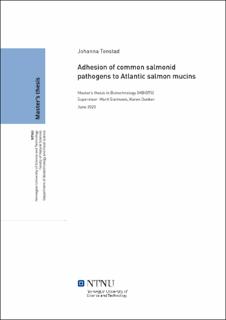| dc.contributor.advisor | Sletmoen, Marit | |
| dc.contributor.advisor | Dunker, Karen | |
| dc.contributor.author | Tonstad, Johanna | |
| dc.date.accessioned | 2021-09-25T16:10:44Z | |
| dc.date.available | 2021-09-25T16:10:44Z | |
| dc.date.issued | 2020 | |
| dc.identifier | no.ntnu:inspera:56743445:15169966 | |
| dc.identifier.uri | https://hdl.handle.net/11250/2782583 | |
| dc.description.abstract | Fisk er dekket av slimhinner, mucus, på alle ytre overflateepitel, som utgjør den første forsvarslinjen mot farlige organismer. Skal et patogen infisere en fisk, må det først passere gjennom denne barrieren i skinnet, tarmen eller gjellene til fisken. Mucin er en av hovedkomponentene i mucus, og dette glykoproteinet har ulike funksjoner i bakteriell adhesjon. I senere tid har det blitt viktig å oppnå en forståelse av egenskapene til mucinene og hvordan de interagerer med bakterier for å utvikle nye strategier for å forhindre sykdomsutbrudd i havbruksnæringen. I dag er denne forskningen på adhesjonsmekanismer mellom patogener og mucusoverflatene til fisk mangelfull. Hovedmålet med denne masteroppgaven var å undersøke og få kunnskap om adhesjonsmekanismene til de patogene bakteriene Aeromonas Salmonicida og Yersinia Ruckeri på atlanterhavslaks (Salmo salar).
Atomkraftmikroskopi (AFM) ble brukt for å samle den eksperimentelle dataen som ble presentert i denne oppgaven. Dette instrumentet kan måle interaksjoner helt ned på piconewton nivå, som kan gi en indikasjon på typen interaksjon som oppstår mellom bakterier og muciner. AFM målinger resulterte i kraftkurver som kunne brukes til å bestemme deadhesjonsarbeid og brytningskrefter for interaksjoner mellom de patogene bakteriene og muciner fra skinnet og tarmen til atlanterhavlaks. Det målte deadhesjonsarbeidet viste at A. Salmonicida festet seg lite til begge typer muciner, mens Y. Ruckeri festet seg bedre til skinnet enn til tarmen. Brytningskreftene var relativt lave for interaksjoner med begge typer bakterier, som indikerer at bakteriene binder seg til mucusoverflater med svake intermolekylære interaksjoner. For å undersøke rollen til sialinsyrer i adhesjonen til bakteriene ble det gjennomført AFM målinger av bakteriene og muciner behandlet med neuraminidase. Resultatene fra disse eksperimentene indikerte at Y. Ruckeri har lektiner som spesifikt kan binde seg til sialinsyre, mens adhesjon av A. Salmonicida blir hindret av disse strukturene.
I tillegg ble adhesjonen av A. Salmonicida direkte til skinnet på lakseyngel målt, men ingen interaksjoner ble målt. | |
| dc.description.abstract | Fish are covered by mucus on all external epithelial surfaces, constituting the first line of defense against hazardous organisms. For a pathogen to enter and infect the fish, it must first pass through this barrier in the skin, the gut or the gills. Mucins are the major constituent of mucus, and these glycoproteins play various roles in bacterial adhesion. Understanding the properties of these mucins and how they interact with bacteria, is of great importance for the development of different strategies to prevent outbreaks of disease in the aquaculture industry. Nonetheless, the research into the adhesion mechanisms of pathogens to mucosal barriers of fish is limited. The main objective of this study was to investigate the adhesion of the pathogenic bacteria Aeromonas Salmonicida and Yersinia Ruckeri to Atlantic salmon (Salmo salar), to gain knowledge of the adhesion strategies executed by these salmonid pathogens.
The experimental data presented in this thesis was obtained by AFM operated in force spectroscopy mode. This tool enables detection of interactions in the piconewton range and can give an indication of the adhesive strength and the interaction type of a bacteria. Force curves were obtained through AFM measurements, and deadhesion work and rupture forces of interactions between the pathogens and Atlantic salmon skin and gut mucins were determined. Deadhesion work showed that A. Salmonicida had relatively little binding with both types of mucins, and that Y. Ruckeri bound better to skin than gut mucins. The rupture forces were relatively weak for interactions with both types of bacteria indicating that the bacteria adhere to the mucosal surfaces with weak intermolecular interactions. To investigate the role of sialic acids in adhesion of the pathogens, AFM measurements were executed with the pathogens and mucins treated with neuraminidase. The results from these experiments suggested that Y. Ruckeri had sialic acid-specific lectins, whereas adhesion of A. Salmonicida is hindered by these terminal residues. Furthermore, measurements were executed with A. Salmonicida directly to the skin mucosa of salmon fry, although no interactions were recorded. | |
| dc.language | | |
| dc.publisher | NTNU | |
| dc.title | Adhesion of common salmonid pathogens to Atlantic salmon mucins | |
| dc.type | Master thesis | |
